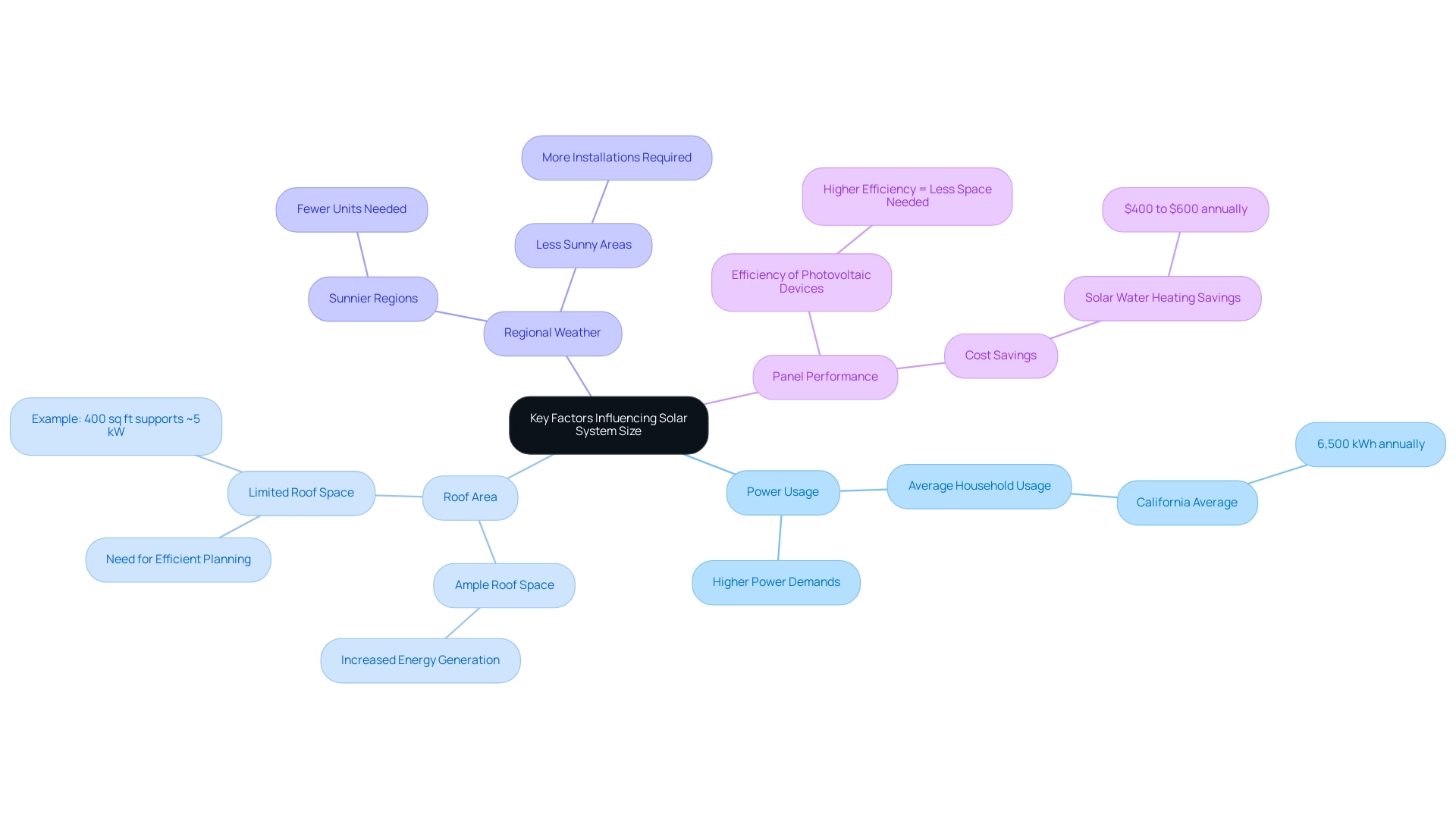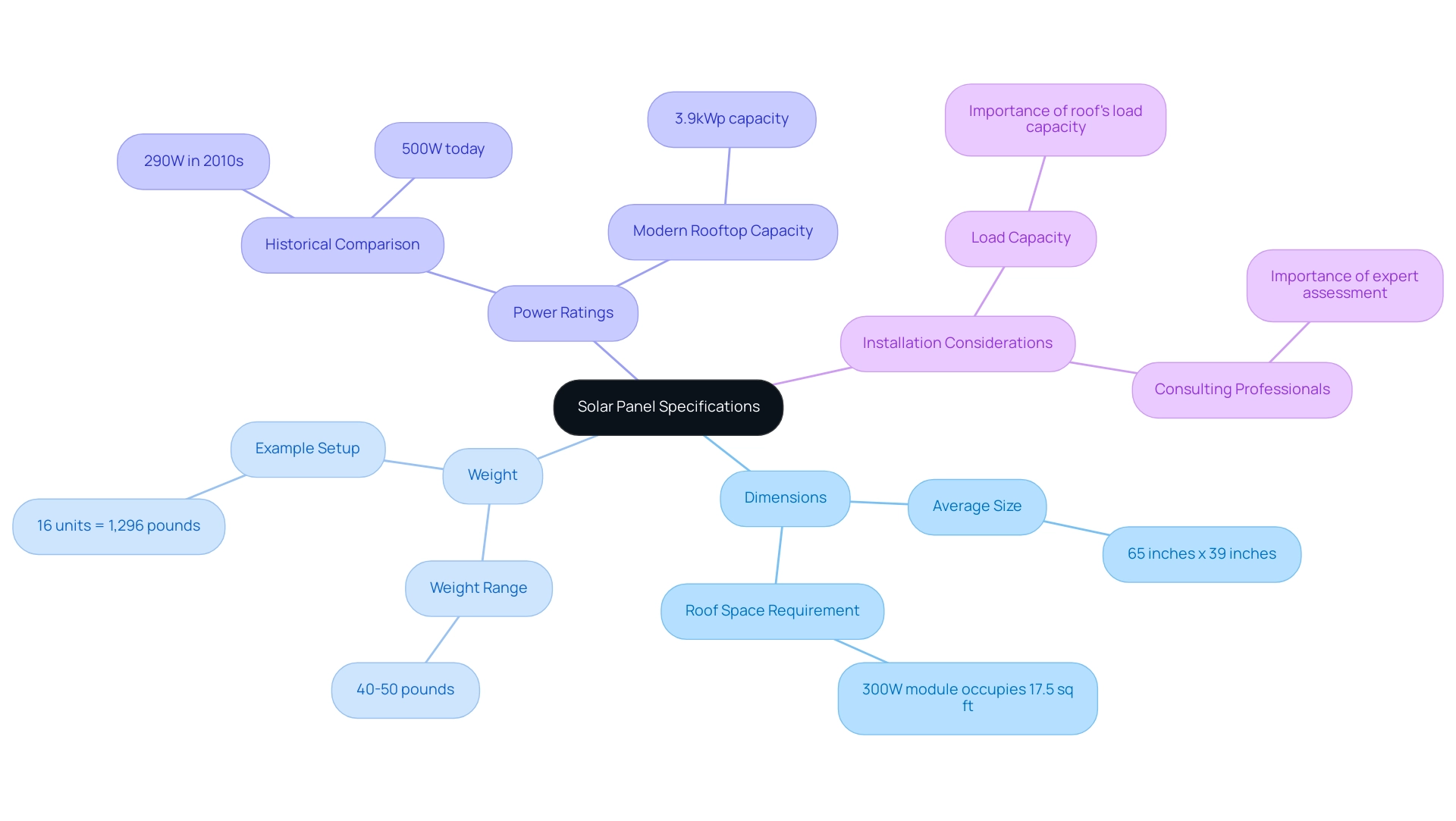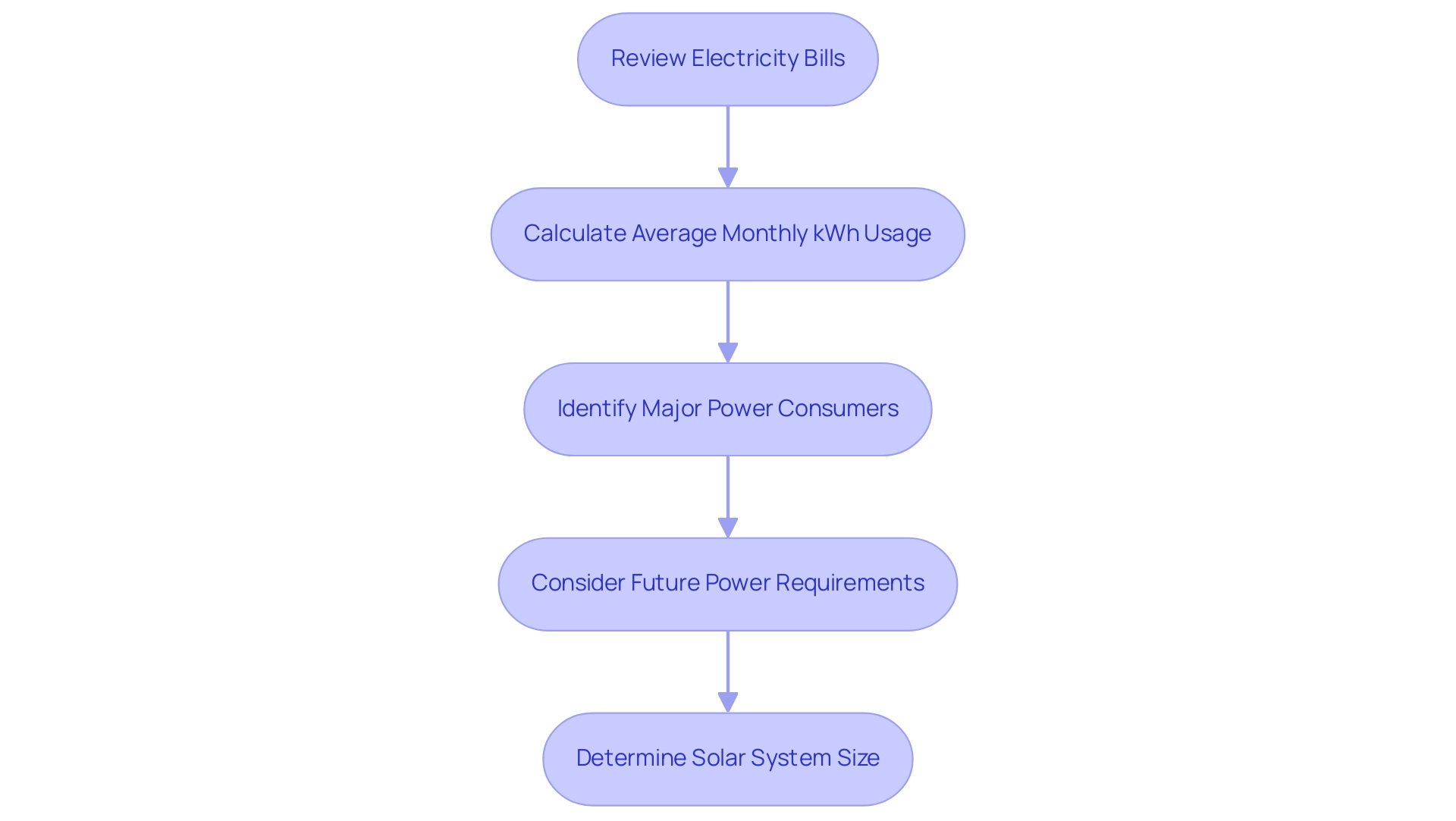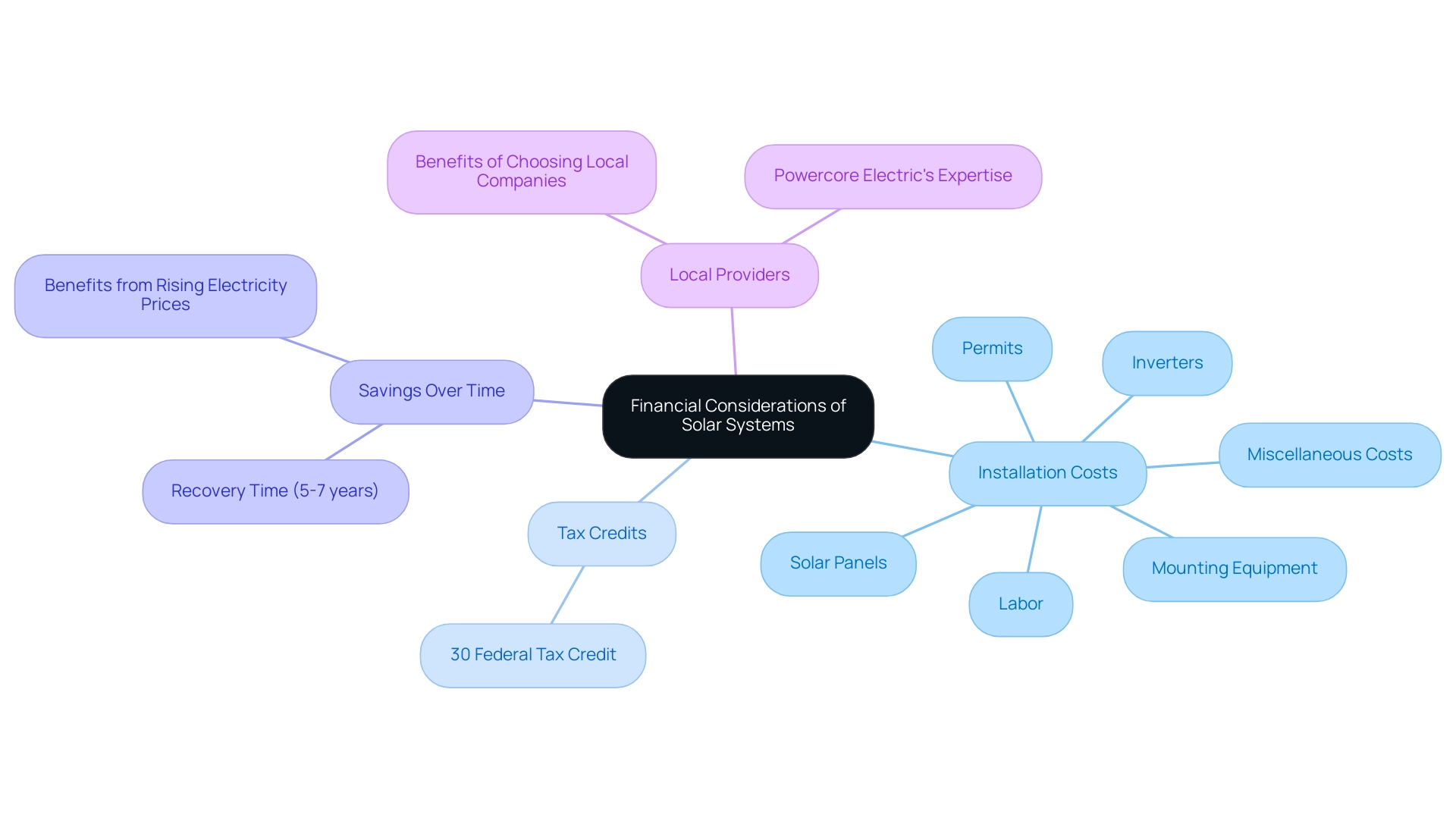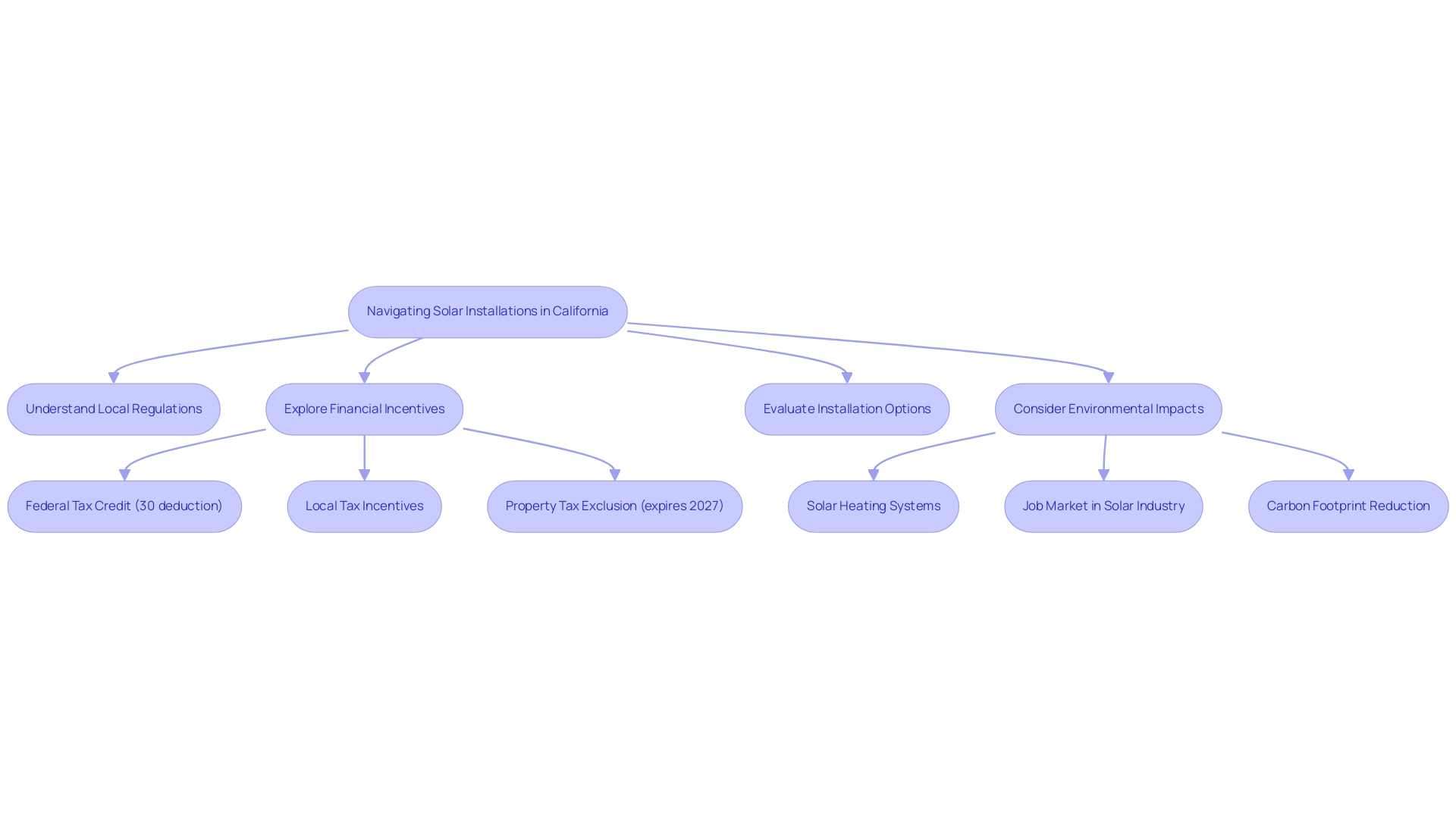Overview
We understand that the rising energy bills can be a significant concern for many homeowners. The typical home solar system size ranges from 5 kW to 10 kW, effectively meeting the energy needs of an average household while significantly reducing those bills. This range is influenced by factors such as:
- Household power usage
- Available roof space
- Advancements in solar technology
By customizing their systems, homeowners can achieve optimal energy efficiency and savings. Together, we can explore how solar energy not only alleviates financial stress but also paves the way for energy independence. Let’s work towards a brighter, more sustainable future for your home.
Introduction
As we navigate a world increasingly focused on renewable energy, many homeowners find themselves concerned about rising energy bills and seeking ways to enhance their energy independence and sustainability. Understanding the intricacies of home solar systems is essential in this journey. With typical solar system sizes ranging from 5 kW to 10 kW—shaped by factors such as household energy consumption and available roof space—homeowners are presented with a wealth of options tailored to their unique needs.
In California, where solar adoption is leading the charge, the market is experiencing both growth and challenges. Innovations in technology and enticing financial incentives are paving the way for more efficient installations, making the prospect of solar energy even more appealing.
This article aims to address your concerns by delving into the key considerations for sizing a solar system. From calculating your energy needs to understanding the impact of roof orientation and panel efficiency, we provide you with the knowledge necessary to make informed decisions on your solar journey. Together, we can explore the possibilities that solar energy offers and work towards a more sustainable future.
What is a Typical Home Solar System Size?
We understand that many homeowners are concerned about rising energy bills and are seeking effective solutions. The typical home solar system size generally ranges from 5 kW to 10 kW, influenced by factors such as household power usage and the available roof area. This range typically corresponds to about 15 to 25 panels, which can significantly offset a home’s electricity needs, even on cloudy days. For instance, a 6 kW system can produce roughly 7,200 kWh each year, satisfying the power requirements of a typical household.
As we look towards 2025, the expected typical home solar system size for residences in California aligns with this range, reflecting a growing trend towards larger setups. Homeowners are increasingly aiming to enhance their autonomy and savings. Current statistics show that the renewable energy sector has installed over 30 GW of capacity through Q3 2024, solidifying this technology as the leading source for new energy capacity in the U.S. However, it’s common to feel concerned about market fluctuations, as there was a 4% decline in residential energy installations during this period, highlighting some challenges.
This growth is further supported by the Inflation Reduction Act, which has enhanced market certainty and is projected to boost renewable energy deployment by 46% over the next five years.
Real-world examples illustrate the effectiveness of systems that fall within the typical home solar system size. For example, a 5 kW system can produce around 6,000 kWh per year, while a 10 kW system can yield approximately 12,000 kWh annually. These results show how property owners can customize their renewable solutions to meet specific power requirements, even in less-than-ideal weather conditions.
Expert views emphasize the importance of evaluating personal power usage trends when determining the typical home solar system size. Anna Brui, a passionate advocate for renewable resources and sustainability, highlights that understanding this size and its outputs is crucial for residents aiming to make informed choices that align with their power objectives and contribute to a sustainable future. Furthermore, Powercore Electric’s internal group of specialists guarantees high-quality installations and maintenance, reinforcing the company’s commitment to delivering reliable energy solutions.
By integrating these insights, homeowners can better navigate their options and enhance their power autonomy. Together, we can explore local renewable energy firms in Stockton, California, that offer tailored advice and support to help you on this journey.
Key Factors Influencing Solar System Size
Understanding the optimal dimensions for a typical home solar system can feel overwhelming, especially when considering your household’s energy bills. Factors such as your power usage, available roof area, regional weather conditions, and panel performance all play a crucial role. In California, for instance, the average household power usage is estimated to be about 6,500 kWh annually in 2025. This figure serves as a helpful benchmark when determining the right size for a home solar system. If your household has higher power demands, you might need a larger system to effectively offset your electricity usage.
Your roof space is another important consideration. Homes with ample roof area can accommodate more solar units, significantly increasing energy generation potential. On the other hand, properties with limited roof space may require thoughtful planning to maximize efficiency. For example, a home with 400 square feet of usable roof space could typically support a solar system size of around 5 kW, depending on the efficiency of the modules.
Local climate conditions also play a vital role in system sizing. Homes in sunnier regions can achieve desired power outputs with fewer units, while those in less sunny areas may need additional installations to meet their energy needs. This is particularly relevant in California, where power generation can vary significantly based on geographic location.
We understand that the effectiveness of photovoltaic devices is crucial as well. More efficient systems can generate greater energy in a smaller area, allowing homeowners with limited roof space to still achieve their energy goals. As technology advances, we are seeing a trend toward increasingly efficient photovoltaic panels, which can influence your system sizing decisions.
This efficiency not only improves performance but also leads to significant cost savings. For instance, solar-powered water heating systems can save homeowners between $400 to $600 each year on utility bills.
According to Ben Zientara, a writer and energy policy analyst, “38% of all companies in the renewable energy sector expect to grow in 2025, and an additional 35% think they will maintain the same level of business.” This expectation of growth underscores the rising importance of renewable energy options for homeowners like you, especially as you seek to enhance energy autonomy and promote sustainability.
Case studies reveal that understanding these factors is essential for customizing solutions to meet individual needs. For example, the “Application Segment Analysis of Residential Solar Power Systems Market” shows how various offerings cater to different sectors, emphasizing the importance of tailoring systems based on specific household requirements. Moreover, it’s significant that women make up 40% of the workforce in the photovoltaic industry, highlighting the diversity within the sector that may resonate with environmentally conscious homeowners.
While photovoltaic technology helps reduce emissions, it’s important to acknowledge its environmental downsides, including impacts on biodiversity, habitat loss, resource consumption, and disposal issues. By considering these elements, you can make informed decisions about your energy investments, ensuring you choose a system that aligns with your energy usage and available resources. Together, we can contribute to a healthier planet.
Average Dimensions and Weight of Solar Panels
As homeowners, it’s natural to feel concerned about rising energy bills and the impact they have on your budget. Understanding the specifications of residential photovoltaic modules is an important step towards embracing sustainable solutions. Typically, these modules measure around 65 inches by 39 inches (1.65m x 1m) and weigh between 40 to 50 pounds. While these specifications can vary slightly by manufacturer and model, having a grasp of the average dimensions and weight is essential for you. This knowledge directly influences installation logistics and ensures the structural integrity of your roof.
For instance, a standard 300W module occupies about 17.5 square feet of roof space. This makes it crucial to consider your roof’s load capacity when planning a solar installation. We understand that navigating these details can feel overwhelming, but it’s a vital part of ensuring your home can support a solar energy system.
As solar technology has advanced, so too has the average power rating of residential solar modules. Today, contemporary modules can exceed 500W, a significant increase from the approximately 290W seen in the 2010s. This progress allows you to achieve higher energy outputs with fewer units, optimizing both your space and efficiency.
Imagine a modern rooftop capable of supporting a power system exceeding the typical home solar system size, boasting a rating of 3.9kWp—over five times the capacity of earlier systems used by NASA. Reflecting on NASA’s historical energy ratings illustrates the remarkable advancements made in photovoltaic technology over the past 60 years, showcasing the incredible developments achieved in this sector.
It’s also important to consider that the weight of photovoltaic units can vary based on the number of units and their dimensions. For example, a setup of 16 units covering 288 square feet would weigh around 1,296 pounds. This weight consideration is crucial during installation, as it affects your roof’s load-bearing capacity and may necessitate structural reinforcements.
As industry expert Andy Sendy emphasizes, understanding these logistics is essential for ensuring safe and effective installations. Installation challenges related to panel size and weight can arise, particularly in older homes or those with less robust roofing structures. It’s common to feel uncertain in these situations, which is why consulting with experienced professionals, such as those at Powercore Electric, is so important. They can assess your specific circumstances to ensure safe and effective installations.
By grasping these elements, you can make informed decisions regarding your home solar system size, ultimately enhancing your energy independence and sustainability. Together, we can work towards a brighter, more sustainable future for your home.
Assessing Your Home’s Energy Needs
To accurately size a solar system, we understand that homeowners often feel overwhelmed by their power requirements. A careful review of electricity bills is a great starting point. This process involves calculating the average monthly kilowatt-hour (kWh) usage, which can vary based on several factors, including the number of occupants, the types of appliances in use, and seasonal fluctuations in consumption. In California, the average household electricity usage is projected to be around 600 kWh per month in 2025, influenced by the state’s climate and efficiency initiatives.
For instance, if your home uses 800 kWh each month, you would need a system capable of producing roughly 9.6 kWh daily to meet your power needs. This calculation is essential for ensuring that your energy installation is both effective and cost-efficient.
It’s common to feel concerned about high electricity bills, especially when case studies indicate that air conditioning and space heating are major contributors to power consumption in American homes, representing 19% and 12% of total usage, respectively. We encourage homeowners to consider energy-efficient air conditioning systems and optimize their heating practices to reduce overall consumption. By grasping these dynamics, you can make informed choices regarding the typical home solar system size, ensuring you capture sufficient renewable power to reduce your electricity expenses.
Furthermore, tenants in Long Beach can explore government initiatives that provide access to renewable solutions, including incentives for installing photovoltaic panels and battery options. Professional guidance suggests that property owners should also consider potential future power requirements, such as the inclusion of electric vehicles or new appliances, when determining the typical home solar system size. This proactive approach not only enhances your independence in resources but also contributes to a sustainable future, aligning with California’s commitment to reducing carbon emissions, which totaled 326.2 million metric tons last year.
Hannah Bastawrose, a mechanical engineering graduate, emphasizes the importance of understanding power consumption patterns: “By analyzing your usage, you can better determine the typical home solar system size that will ensure it meets your current and future needs.” Additionally, it’s worth noting that states like Hawaii and Connecticut face unique challenges in sourcing and costs, which can lead to higher bills despite lower consumption. This context is beneficial for California residents as they manage their own utility expenses.
By following these steps, you can efficiently evaluate your power needs and choose a photovoltaic system that satisfies your criteria while optimizing your investment. Together, we can work towards a more sustainable and cost-effective energy future.
Calculating the Number of Solar Panels Required
Are you concerned about rising energy bills? Understanding how many photovoltaic modules you need for a typical home solar system can be a crucial step toward energy independence. A simple formula can guide you: divide your total yearly power usage (in kWh) by the yearly output of one photovoltaic unit (also in kWh). For example, if your household uses 10,000 kWh of power each year and each module produces about 300 kWh yearly, the calculation would be:
10,000 kWh ÷ 300 kWh/module = approximately 33 modules.
This computation not only helps you grasp the extent of your renewable investment but also supports you in strategizing for your power requirements efficiently. Looking ahead to 2025, the typical home solar system size for a residence in California is anticipated to be designed for around 10,800 kWh of yearly power consumption. This may require adjustments in the quantity of modules needed, depending on your personal power usage habits.
As production of photovoltaic units continues to rise, with forecasts suggesting significant growth in manufacturing capacities, you can look forward to a stronger supply of these units. In fact, global photovoltaic investments surged by approximately 30% in 2023, exceeding USD 480 billion. This highlights the increasing commitment to renewable power solutions and is essential for homeowners like you who are contemplating installations, indicating a strengthening market and enhanced accessibility of energy technology.
Moreover, China represented nearly 95% of new facilities across the photovoltaic supply chain in 2023, showcasing the global landscape of photovoltaic production and its effects on availability. The establishment of new manufacturing facilities for battery storage systems (BESS) and electric vehicles (EV) further enhances the broader power ecosystem, making photovoltaic solutions more viable and integrated.
Consider how various households have successfully determined their photovoltaic needs based on power consumption. For instance, a family that adopted energy-efficient appliances and practices was able to lower their annual consumption to 8,000 kWh, resulting in a need for approximately 27 units. This example underscores the importance of assessing your personal power habits when determining your requirements for a typical home solar system size, ensuring that you can optimize your investment in renewable resources.
Additionally, advancements in photovoltaic technology, such as the development of smarter inverter systems, are essential for improving the efficiency and effectiveness of installations, facilitating better integration into the grid. If you live in Stockton, California, you can explore local energy firms that provide customized solutions to address your specific energy requirements. This can further enhance your understanding of residential energy system sizes and advantages under the 200% rule. Together, we can pave the way for a sustainable future.
The Role of Roof Space and Orientation
We understand that rising energy bills can be a significant concern for many homeowners. The effectiveness of a photovoltaic installation is heavily influenced by the available roof space and its orientation. For optimal performance, photovoltaic units should ideally be placed on south-facing roofs, as this positioning maximizes sunlight exposure throughout the day. In fact, research suggests that south-facing setups can enhance power generation by as much as 20% relative to other directions.
The total space available for panel installation is vital, as it influences the typical home solar system size by determining how many panels can be fitted, which directly affects the system’s overall capacity. Before installation, it’s crucial for homeowners to carefully evaluate their roof’s condition and orientation. A case study from Q3 2024 highlighted that homes with sufficient roof space and ideal orientation experienced a notable rise in savings, even in a difficult market context where residential installations faced a 4% drop quarter-over-quarter due to increasing financing costs and regulatory changes.
This reduction is especially troubling considering that elevated household electricity expenses and power interruptions have been increasing the need for renewable solutions. Furthermore, comprehending battery capacity and power ratings is crucial for efficient resource management. Power storage capacity, measured in kilowatt-hours (kWh), indicates how much electricity a cell can hold, while power ratings, expressed in kilowatts (kW), determine how much electricity can be utilized at once.
Aligning these specifications with your home electricity requirements ensures continuous power during high demand periods. As residential photovoltaic and storage expenses keep decreasing, the financial attractiveness of combining battery systems with photovoltaic panels increases. This is especially beneficial for a typical home solar system size, enabling residents to store excess power and use it during peak demand periods, thereby lowering utility expenses and improving power independence.
The influence of roof space on photovoltaic panel efficiency cannot be overstated. In 2025, it is anticipated that homes with adequate roof area will continue benefiting from improved power generation, emphasizing the significance of evaluating roof conditions prior to proceeding with installation. As the photovoltaic industry evolves, it is noteworthy that women accounted for 40% of the total workforce in this sector as of 2021, highlighting the diversity within the industry.
By understanding these factors, including the expectation of a fivefold increase in photovoltaic generation by 2030, homeowners can make informed decisions that lead to effective and sustainable energy solutions. As Inemesit Ukpanah, a seasoned content writer, emphasizes, understanding roof conditions is crucial for maximizing the benefits of photovoltaic installations. Together, we can work towards a more sustainable future, ensuring that your home is equipped to meet its energy needs efficiently.
Understanding Solar Panel Efficiency and Output
Understanding the efficiency of photovoltaic systems is essential for homeowners concerned about rising energy bills. These systems play a crucial role in how effectively sunlight is transformed into usable electricity. Typically, residential solar installations exhibit efficiencies ranging from 15% to 22%. Higher efficiency units are particularly beneficial for those with limited roof space, as they generate more electricity per square foot.
For example, consider a 300W module operating at 20% efficiency. It will produce significantly more energy than a similar 300W unit with only 15% efficiency over the same timeframe. This difference can make a substantial impact on your energy savings.
As we look ahead to 2025, the average efficiency of residential solar systems has improved, with many high-efficiency models now available. Notably, Canadian Solar’s HiKu6 module stands out as one of the largest in terms of wattage, boasting a temperature coefficient of -0.29% and a 25-year production guarantee of 89.4%. This performance metric is vital for homeowners to consider, as it directly affects long-term power output and dependability.
Comprehending solar panel efficiency ratings is crucial for individuals aiming to maximize their energy production. Recent data indicates that 7% of property owners have opted for battery storage solutions, primarily to take advantage of time-of-use rates. This statistic highlights a growing trend among homeowners seeking backup power options, with 80% citing access to backup power as their main motivation for installation in 2024.
This trend underscores the significance of choosing high-efficiency units that can effectively meet power needs, especially during peak usage periods. Furthermore, combining battery storage with photovoltaic systems enhances power management and sustainability. It allows homeowners to store surplus power generated during the day for use during peak times or outages. Powercore Electric offers some of the top battery options for effective storage, including the Tesla Powerwall and LG Chem RESU, designed to operate seamlessly with high-efficiency photovoltaic units. Expert insights further emphasize the importance of efficiency in energy output.
As Daniel Ciolkosz, a professor of Agricultural and Biological Engineering at Pennsylvania State University, noted, “If something is 20% efficient, that means that 20% of the power in that sunlight reaching the panel gets converted into moving electrons.” This practical viewpoint highlights the importance of efficiency for homeowners seeking to invest in renewable energy. By understanding these efficiency ratings and their implications, individuals can make informed decisions that align with their energy needs and sustainability goals.
Additionally, the current energy sector landscape is marked by uncertainty, as highlighted in the case study titled ‘Uncertainty in the Energy Industry for 2025.’ Possible funding delays from the Inflation Reduction Act and tariffs on imported panels raise concerns among energy companies, which could affect residents contemplating energy investments. By staying informed about these developments, homeowners can explore their options more effectively in the evolving energy market.
Financial Considerations: Costs and Savings of Solar Systems
We understand that the cost of installing a photovoltaic system can be daunting, influenced by various factors such as the typical home solar system size, panel quality, and installation complexity. In California, homeowners typically encounter installation expenses ranging from $15,000 to $25,000 for a complete energy system. However, the federal renewable energy tax credit, which allows for a 30% deduction on installation and equipment costs, can significantly alleviate these expenses.
For instance, a standard 5kW panel system might initially range from $12,500 to $17,300 before tax credits, making renewable power more financially attainable for you and your family.
Over time, energy systems can yield considerable savings on electricity bills. Many homeowners discover that they can recover their initial investment within 5 to 7 years, thanks to lowered utility expenses and potential increases in property value. This financial return is further supported by the growing trend of rising electricity prices, which makes renewable energy an increasingly attractive option for long-term savings.
Moreover, choosing a small or mid-size, local, family-owned energy company like Powercore Electric can enhance your experience. These companies often provide better service and support, ensuring that you won’t be left navigating corporate call centers for years. As industry expert Andy Sendy aptly puts it, “You don’t want to be on hold with a corporation’s call center for the next 25 years!”
This emphasizes the importance of personalized service in the installation process of renewable energy systems. Powercore Electric’s in-house team of experts guarantees high-quality installations and maintenance, further enhancing your experience.
Consider what others are saying:
- Ryan: “Ryan and his team were great. They were quick, effective, and adhered to the timeline for our energy installation. I have referred Powercore to some friends, and they were also happy with their service. I’d definitely recommend Ryan and Powercore Electric.”
By understanding these financial elements and the advantages of collaborating with a local provider, you can make informed choices about shifting to renewable sources, ultimately resulting in improved autonomy and sustainability.
Cost Breakdown of a Solar Panel System:
- Solar Panels: $X
- Inverters: $Y
- Mounting Equipment: $Z
- Labor: $A
- Permits: $B
- Miscellaneous Costs: $C
This detailed breakdown, as outlined in the case study titled “Cost Breakdown of a Solar Panel System,” provides you with a clearer understanding of the financial commitment involved in solar energy adoption.
Navigating Local Regulations and Incentives for Solar Installations
As you contemplate the journey of installing photovoltaic panels, it’s crucial to fully grasp local regulations, permitting requirements, and the range of incentives available in California. We understand that navigating these aspects can feel overwhelming. Starting in 2025, California homeowners will have the opportunity to benefit from various financial incentives aimed at promoting energy adoption. Notably, the federal tax credit allows for a 30% deduction on the cost of renewable energy installations, significantly easing those initial financial burdens.
Additionally, many local tax incentives can further alleviate the upfront investment, making renewable energy solutions even more appealing. Beyond federal incentives, California offers a property tax exclusion for renewable energy installations, which is set to sunset on January 1, 2027. It’s common to feel uncertain about timing, but homeowners should be aware that after this date, the exclusion may no longer apply unless extended by future legislation. This emphasizes the importance of acting sooner rather than later to maximize your financial benefits.
Imagine the considerable savings on utility costs—estimates suggest annual savings ranging from $400 to $600. This can significantly enhance your return on investment, allowing you to invest in other areas of your life. Understanding local zoning laws and property owners’ association (POA) regulations is equally vital. By adhering to these regulations, you can avoid potential issues during the installation phase, ensuring a smoother transition to renewable power. Importantly, California’s panel legislation does not mandate the installation of batteries, offering you flexibility in your renewable systems.
The California Energy Commission’s recent estimates indicate that this mandate will add an impressive 280 MW of capacity each year to commercial properties, showcasing the state’s commitment to enhancing renewable resources. Moreover, the renewable industry in California supports approximately 80,056 jobs across 2,476 businesses, highlighting the sector’s significant economic impact and our community’s dedication to sustainable practices. By opting for solar heating systems that harness sunlight, you can also reduce your carbon footprint, preventing around 2 tons of carbon dioxide from entering the atmosphere each year—akin to not using a vehicle for four months.
As you navigate these incentives, consider drawing inspiration from case studies of others who have successfully leveraged local regulations and financial advantages to install solar systems. This further illustrates the benefits of transitioning to solar power. Powercore Electric is here to provide expert guidance, helping you understand and navigate these incentives and regulations with ease. Together, we can thoroughly assess both the financial and environmental impacts, creating a more sustainable future while enjoying the tangible financial savings from reduced dependence on conventional power sources.
The Benefits of Understanding Solar System Sizes
Understanding the dimensions of planetary systems is essential for homeowners who wish to make informed decisions about their energy needs and investments. We recognize that energy bills can be a source of stress, and by evaluating factors such as power consumption, available rooftop space, and local regulations, property owners can create a tailored solution that not only boosts efficiency but also leads to significant savings. In 2025, a remarkable 78% of installers anticipate an increase in sales, reflecting a growing interest in renewable solutions, particularly among environmentally conscious homeowners in areas like Long Beach.
However, it’s important to acknowledge that the depletion of California’s project queue and rising financing costs have posed challenges for residential installations, resulting in a projected downturn in 2024. Yet, awareness of financial incentives, such as the 200% rule, and understanding the implications of efficiency can greatly enhance long-term outcomes. For instance, a study by the Lawrence Berkeley National Laboratory revealed that photovoltaic installations can increase a home’s value by approximately $15,000 on average, underscoring the financial benefits of informed photovoltaic investments.
Grasping the typical home solar system size not only supports self-sufficiency but also aligns with our collective goal of sustainability. As the global photovoltaic market is projected to grow from around £67.8 billion in 2022 to about £161.9 billion by 2030—driven by technological advancements and heightened environmental awareness—homeowners are increasingly recognizing the importance of customized photovoltaic solutions.
Moreover, considerations regarding the sustainability of photovoltaic panels, including their materials and recycling challenges, should be factored into photovoltaic investments. Many homeowners have made informed choices based on their understanding of the typical home solar system size, leading to greater autonomy and reduced reliance on traditional energy sources. By focusing on the typical home solar system size, residents can navigate the complexities of renewable energy and contribute to a more sustainable future.
Additionally, the ‘Unlocking Solar Power’ guide for Long Beach renters offers valuable insights into accessing eco-friendly energy solutions, while case studies demonstrate how homeowners have successfully benefited from understanding solar system sizes under the 200% rule. Together, we can work towards a brighter, more sustainable future for our communities.
Conclusion
Understanding the intricacies of home solar systems is essential for homeowners who are concerned about rising energy bills and seeking greater energy independence and sustainability. By thoughtfully evaluating factors such as:
- Energy consumption
- Available roof space
- Local climate conditions
you can effectively determine the optimal size for your solar installations. Typically, a range of 5 kW to 10 kW can provide significant energy offsets, highlighting the importance of tailored solar solutions that cater to your unique needs.
As the solar market evolves, innovations in technology and financial incentives are making solar energy increasingly accessible and appealing. Homeowners in California, in particular, can benefit from a variety of incentives and regulations designed to facilitate the transition to solar power. By understanding these financial aspects, alongside the implications of solar panel efficiency and output, you can unlock substantial long-term savings and potentially increase your property value.
Ultimately, embarking on the journey toward adopting solar energy is about more than just reducing electricity bills; it represents a crucial step toward a more sustainable future. By prioritizing knowledge about solar system sizes and the factors that influence their effectiveness, you can make informed decisions that contribute to a cleaner environment and a more resilient energy landscape. Embracing solar energy is a commitment to both personal energy independence and the broader goal of sustainability in our ever-changing world. Together, we can take meaningful steps toward a brighter, greener future.



